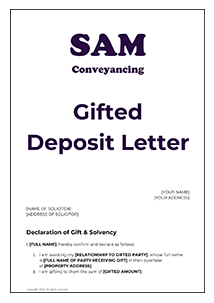What is the Stamp Duty Loophole?
Many buyers, especially landlords or those moving up the property ladder without first-time buyer relief, are looking for ways to reduce Stamp Duty Land Tax (SDLT).
There are several ways to reduce your Stamp Duty Land Tax (SDLT) burden. These range from simple tactics like negotiating the purchase price and claiming available reliefs (such as those for first-time buyers and main residences) to more complex planning strategies, including exploiting the rules around fixtures and fittings, utilising genuine gifts, building your own home, and non-standard dwellings like houseboats.
You may have heard of a Stamp Duty loophole, primarily used by the very wealthy on commercial property, where a company uses a 'special purchase vehicle' (SPV) to hold the property. This way you can buy some of all of the shares in the SPV (and, indirectly, the property) and pay tax at the 0.5% rate on shares, rather than pay SDLT at the prevailing rate. However, SDLT will or would have been payable when the property was transferred to the company in the first place.
Is this tax avoidance?
If the current owners transfer the property to an SPV and then immediately sell it to you, so you only pay SDLT on the shares, this would be tax avoidance. The property must belong to the SPV for three years before transfer for you to benefit; otherwise, you'll still have to pay your SDLT.
Residential property held by companies is subject to annual tax on enveloped dwellings (ATED) so the SPV stamp duty loophole is mostly redundant.
What are the Stamp Duty changes?
On April 1st, 2025, first-time homebuyers in England saw a change in Stamp Duty Land Tax (SDLT) rules.
The threshold at which first-time buyers start paying SDLT decreased from £425,000 to £300,000. Additionally, properties valued at more than £500,000 are subject to the same SDLT rates as those buying a second home or those who are not first-time buyers.
Loopholes to avoid Stamp Duty
While the term "loophole" is often used, it's more accurate to think of these as legitimate ways to reduce your SDLT burden by applying the existing rules and available reliefs.
SDLT rates (Post-April 1st 2025)
For standard purchases (not first-time buyers):
- 0% on the first £125,000.
- 2% on the portion between £125,001 and £250,000.
- 5% on the portion between £250,001 and £925,000.
- 10% on the portion between £925,001 and £1.5 million.
- 12% on any portion above £1.5 million.
For first-time buyers:
- 0% on the first £300,000.
- 5% on the portion between £300,001 and £500,000.
- 10% on the portion above £500,000.
Negotiation on property price - below the threshold
SDLT is calculated based on the purchase price and is structured in bands or thresholds. Each band has a different tax rate.
Therefore, even a small reduction in the agreed purchase price can move you into a lower tax bracket, resulting in substantial savings. This is especially relevant when the asking price is close to a threshold.
For example, a property is listed for £310,000. For a first-time buyer, this would mean SDLT is payable on the portion between £300,001 and £310,000, which is £9,999. At a rate of 5%, this equates to approximately £500 in SDLT (£499.95 rounded up).
If the first-time buyer successfully negotiates the price down by £10,001 to £299,999, they would pay no SDLT. Even a relatively modest reduction can result in real savings, especially for first-time buyers close to the £300,000 threshold.
It's important to remember that sellers are not obligated to accept a lower offer, but it's always worth negotiating.

Don't leave money on the table, our solicitors will help you negotiate the best possible price.
- Your interests are protected.
- Expert negotiators.
- Suitable for negotiating offers after survey.
- No obligation to move forward after quote.
Asking the current owner to deduct fixtures and fittings
Certain items considered "fixtures and fittings" in a property purchase can reduce the amount on which SDLT is calculated.
It's sometimes possible to negotiate a separate price for these to drop the overall asking price, but they must be removable so already-fitted kitchens and bathrooms won't apply here.
Fixtures are items permanently attached to the property (e.g., fitted kitchens, bathroom suites, built-in wardrobes), and their value is included in the purchase price for SDLT calculations. Fittings are items not permanently attached and can be removed (e.g., freestanding furniture, curtains, rugs, white goods).
For example, a buyer agrees to purchase a house for £300,000. After negotiation, they agree that £5,000 worth of items (e.g., freestanding wardrobes, curtains, and a washing machine) are fittings and will be purchased separately.
This reduces the taxable amount for SDLT to £295,000. While this might seem like a small amount, it can still result in a saving for standard buyers.
You need this properly documented with a detailed inventory agreed upon by the buyer and seller to avoid any disputes with HMRC. This agreement should be a separate contract from the main property purchase agreement.
It's also important to be realistic about what can be considered fittings. HMRC may challenge arrangements that appear designed solely to avoid SDLT.
Gifting
If you’re buying from a friend or family member and they gift you the property or the portion of the value above the threshold, then you may be able to avoid stamp duty.
For example, a family member sells you a property worth £300,000 for just £125,000, gifting you the other £125,000 value. You pay SDLT based on the consideration of £125,000 and skirt under the new threshold.
The key is that the gift must be unconditional. This means there should be no expectation of repayment, no interest charged, and no requirement for the gifting party to receive any ownership stake in the property.
However, if the grandparent said, "I'll give you £30,000 for the deposit, but you have to pay me back in five years," this would be considered a loan, and the £30,000 would be included in the purchase price for SDLT purposes.
Similarly, if the grandparent received a share of the property in return for the money, this would also be considered part of the purchase.
Any gift should be documented with a formal letter or agreement which clearly states it's an unconditional gift with no expectation of repayment or property rights.
It's also important to be aware of potential inheritance tax implications for the giver of a large gift, especially if they die within seven years of making the gift.
Download a gifted deposit letter template, free from hassle.
- Instant download
- Easy to fill in
- Suitable for mortgage lenders
- Sign, witness and gift the money
The templates will be attached to your confirmation email after payment. Please allow a couple of minutes for the email to arrive.

£4.99 INC VAT
Building your own home
Instead of paying SDLT on the total value of a completed property, you typically only pay SDLT on the price of the land itself. This can lead to substantial savings, especially in areas with high property values. However, it isn't always straightforward.
- Planning Permission: You'll need to obtain the necessary planning permission before starting construction. This can be a complex and time-consuming process.
- Building Regulations: Your construction must comply with building regulations, which ensure safety and quality standards.
- Timelines: There may be time limits for completing the construction to qualify for the SDLT relief. This means the construction must be completed within a specified period after purchasing the land. Failing to meet these timelines could result in having to pay SDLT on the full value of the completed property. Contact your local council for specific timeframes
- Self-Build or Custom Build: The rules may differ slightly depending on whether you are undertaking a self-build project (managing the construction yourself) or a custom build (working with a developer). For self-build projects, you may be able to claim back some of the VAT you pay on building materials through the DIY Housebuilder Scheme.
Transfer of Equity
When a marriage or civil partnership breaks down, a transfer of property ownership between the separating parties is often a key part of the financial settlement.
Fortunately, property ownership transfers between spouses or civil partners as a result of a divorce, separation, or dissolution order are generally exempt from SDLT.
This exemption applies even if there is a financial settlement involved, such as one party paying the other a lump sum in exchange for their share of the property. The exemption aims to avoid adding further financial burden to an already difficult situation.
For example, John and Mary are divorcing and jointly own the family home. As part of their financial settlement, John agrees to transfer his share of the property to Mary, who will continue to live there with their children. Even if Mary pays John a lump sum in exchange for his share, no SDLT is payable on the transfer of ownership.
Important Note: This exemption applies specifically to transfers made as a result of a formal court order or a legally binding separation agreement. If the transfer is done outside of these formal processes, SDLT may be payable.
Houseboats, caravans, and other non-standard dwellings
Standard SDLT rules apply to "dwellings," which are defined as buildings used or suitable for use as a single dwelling.
Certain types of properties, such as some houseboats, caravans, mobile homes, and park homes, may not be considered dwellings for SDLT purposes, and therefore different tax rules may apply.
The key factor is whether the property is permanently fixed to land and meets the legal definition of a dwelling.
If it's easily movable or doesn't have a permanent connection to the ground, it's less likely to be treated as a standard dwelling for SDLT.
- The level of permanence of the structure is a key factor.
- Connections to mains gas, water, and electricity can influence the classification.
- Planning permission and site licensing can also play a role in determining whether a property is considered a dwelling for SDLT purposes.
A permanently moored houseboat on a licensed mooring may be subject to different tax rules than a traditional house.
However, you'll need to determine if the mooring is considered a permanent fixture. If the houseboat can be easily moved, it might not be subject to standard SDLT.
A caravan on a holiday park that is not permanently sited and can be towed is unlikely to be considered a dwelling for SDLT.
However, a static caravan on a permanent pitch with connections to utilities might be treated differently.

How To Buy A House Without Killing Anyone could be the difference between every mover’s dream.
Buying and moving into your new home stress-free, or, stress, missed deadlines, legal disasters, building defects, and possibly the collapse of the whole transaction.
(Costing you a small fortune, a head full of grey hairs, and, driving you to threaten the life of your solicitor, lender, co-owners, family, partner, or some combination of all five).
Available on Amazon | Kindle | Paperback
Second home Stamp Duty relief (replacing your main residence)
When you buy a new property but haven't yet sold your existing main residence, you'll usually have to pay the higher rates of SDLT, often referred to as the "second home" surcharge.
This surcharge is an additional 3% on top of the standard SDLT rates. However, there's relief available if you sell your previous main residence within a specific timeframe.
How does the refund work?
If you sell your previous main residence within three years of buying the new property, you can reclaim the extra SDLT you paid.
- When you purchase the new property, you'll initially pay the SDLT including the 3% surcharge.
- You have three years from the date of purchasing the new property to sell your old one.
- Once the sale of your previous main residence is complete, you can claim a refund of the 3% surcharge.
You can claim a refund by completing an online form on the HMRC website. You must make your claim within 12 months of selling your previous main residence (not within 12 months of buying the new one).
For example, you buy a new house on January 1, 2026, but your old house doesn't sell until December 1, 2028 (within the three-year window). You have until December 1, 2029, to claim your SDLT refund.
Can I buy a house in my child's name to avoid Stamp Duty?
The idea of buying a property in your child's name to avoid Stamp Duty Land Tax might seem appealing at first glance. However, it's generally not recommended and can lead to legal, financial, and familial complications.
Legal ownership and control
If the property is legally in your child's name, they are the legal owner. This means they have full control over the property, including the right to sell it, rent it out, or even mortgage it without your consent. This can create significant problems if your child's wishes differ from yours.
Lack of security
You would have no legal right to the property. If your child were to face financial difficulties, such as bankruptcy or divorce, the property could be at risk.
HMRC scrutiny
HMRC actively scrutinises arrangements that appear to be designed primarily to avoid tax. If they deem the purchase in your child's name to be a deliberate attempt at tax avoidance rather than a genuine gift or investment for the child, they could impose penalties, including back taxes, interest, and fines.
Mortgage complications
Obtaining a mortgage in a child's name, especially if they are young or have limited income, can be very difficult. Lenders will carefully assess the child's financial situation and may require parental guarantees, which could negate any potential SDLT savings.
For example, a parent buys a house in their 18-year-old child's name to avoid paying the higher rates of SDLT on a second home.
A few years later, the child decides to sell the property to fund a trip around the world, against the parent's wishes. Because the child is the legal owner, the parent has no legal grounds to stop the sale.

- Expert panel of conveyancing solicitors, with local knowledge.
- Your transaction is protected by our No Sale, No Fee policy. Terms apply.
- Fixed fee conveyancing.
- We are on 99% of mortgage lender panels.
- We can solve any property challenge.
Jack is our resident Content Writer with a wealth of experience in Marketing, Content, and Film. If you need anything written or proof-read at a rapid speed and high quality, he's your guy.
Caragh is an excellent writer and copy editor of books, news articles and editorials. She has written extensively for SAM for a variety of conveyancing, survey, property law and mortgage-related articles.









